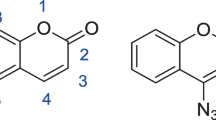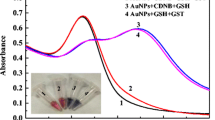Abstract
A novel ratiometric fluorescent sensor was fabricated for the fast and facile determination of cyclosporine A (CsA). Due to the narrow therapeutic index of CsA, its desired therapeutic effects are evident within a limited range of blood concentration, indicating the fundamental role of therapeutic drug monitoring in CsA pharmacological response. In this study, a two-photon fluorescence probe based on the zeolitic imidazolate framework (ZIF-8) and norepinephrine-capped silver nanoparticles (AgNPs@NE) was employed for the quantification of the CsA in human plasma samples. In the presence of CsA, the fluorescent emission intensity of ZIF-8-AgNPs@NE was quenched. Under the optimum conditions, the proposed probe determines CsA in plasma samples in two linear ranges of 0.01 to 0.5 μg mL−1 and 0.5 to 10 μg mL−1. The developed probe demonstrates the advantages of a facile and fast platform with limit of detection as low as 0.007 μg mL−1. At last, this method was applied to find CsA concentration in four patients receiving oral CsA regimen which indicates it as a promising method for on-site detection applications.
Graphical abstract






Similar content being viewed by others
References
Ponticelli C, Glassock RJ (2019) Prevention of complications from use of conventional immunosuppressants: a critical review. J. Nephrol. 32:851–870
Zdanowicz MM (2009) The Pharmacology of Immunosuppression. Am J Pharm Educ 73:144. https://doi.org/10.5688/aj7308144
Hariharan S, Johnson CPBB (2000) Improved graft survival after renal transplantation in the United States, 1988 to 1996. N Engl J Med 342:605–612. https://doi.org/10.1056/NEJM200003023420901
Kahan BD, Keown P, Levy GA, Johnston A (2002) Therapeutic drug monitoring of immunosuppressant drugs in clinical practice. Clin Ther 24:330–350. https://doi.org/10.1016/S0149-2918(02)85038-X
Akhlaghi F, Trull AK (2012) Distribution of cyclosporin in organ transplant recipients. Clin Pharmacokinet 41:615–637. https://doi.org/10.2165/00003088-200241090-00001
Fireman M, DiMartini AF, Armstrong SC, Cozza KL (2004) Immunosuppressants. Psychosomatics 45:354–360. https://doi.org/10.1176/appi.psy.45.4.354
Dumont FJ, Su Q (1995) Mechanism of action of the immunosuppressant rapamycin. Life Sci 58:373–395. https://doi.org/10.1016/0024-3205(95)02233-3
Marzejon M, Kosowska M, Majchrowicz D et al (2019) Label-free optical detection of cyclosporine in biological fluids. J Biophotonics 12:e201800273. https://doi.org/10.1002/jbio.201800273
Gabriel M. Danovitch, Handbook of kidney transplantation, 6th edn. Lippincott Williams & Wilkins (LWW), Alphen aan den Rijn, Netherlands
Jahed FS, Hamidi S, Nemati M (2018) Dopamine-capped silver nanoparticles as a colorimetric probe for on-site detection of cyclosporine. ChemistrySelect 3:13323–13328. https://doi.org/10.1002/SLCT.201802272
Balayeva EZ, Eivazi-Gharamaleki M, Suleymanov TA (2021) Importance of therapeutic drug monitoring of immunosuppressant drugs using cost-effective analytical methods. ImmunoAnalysis 1:11. https://doi.org/10.34172/ia.2021.11
Soleymani J, Golsanamluo Z (2021) Advanced materials for immunosensing of pharmaceutical and drug compounds. ImmunoAnalysis 1:5. https://doi.org/10.34172/ia.2021.05
Golsanamlou Z, Soleymani J, Jouyban A (2021) Sensing methods of immunosuppressant pharmaceutical drugs: calcineurin inhibitors and purine synthesis inhibitor agents. ImmunoAnalysis 1:12. https://doi.org/10.34172/ia.2021.12
Gu GE, Park CS, Cho H-J et al (2018) Fluorescent polydopamine nanoparticles as a probe for zebrafish sensory hair cells targeted in vivo imaging. Sci Rep 8:4393. https://doi.org/10.1038/s41598-018-22828-2
Chen Z, Qian S, Chen X et al (2012) Protein-templated gold nanoclusters as fluorescence probes for the detection of methotrexate. Analyst 137:4356–4361. https://doi.org/10.1039/C2AN35786K
Yu F, Han X, Chen L (2014) Fluorescent probes for hydrogen sulfide detection and bioimaging. Chem Commun 50:12234–12249. https://doi.org/10.1039/c4cc03312d
Mai HH, Tran DH, Janssens E (2019) Non-enzymatic fluorescent glucose sensor using vertically aligned ZnO nanotubes grown by a one-step, seedless hydrothermal method. Microchim Acta 186:245. https://doi.org/10.1007/s00604-019-3353-5
Terai T, Nagano T (2008) Fluorescent probes for bioimaging applications. Curr. Opin. Chem. Biol. 12:515–521
Mansouri A, Abnous K, Nabavinia MS et al (2020) In vitro selection of tacrolimus binding aptamer by systematic evolution of ligands by exponential enrichment method for the development of a fluorescent aptasensor for sensitive detection of tacrolimus. J Pharm Biomed Anal 177:112853. https://doi.org/10.1016/j.jpba.2019.112853
Park SH, Kwon N, Lee JH et al (2020) Synthetic ratiometric fluorescent probes for detection of ions. Chem Soc Rev 49:143–179. https://doi.org/10.1039/c9cs00243j
Pan Y, Liu Y, Zeng G et al (2011) Rapid synthesis of zeolitic imidazolate framework-8 (ZIF-8) nanocrystals in an aqueous system. Chem Commun 47:2071–2073. https://doi.org/10.1039/C0CC05002D
Mokashi VV, Gore AH, Sudarsan V et al (2012) Evaluation of interparticle interaction between colloidal Ag nanoparticles coated with trisodium citrate and safranine by using FRET: Spectroscopic and mechanistic approach. J Photochem Photobiol B Biol 113:63–69. https://doi.org/10.1016/j.jphotobiol.2012.05.006
Zhang Z, Hao J, Zhang J et al (2012) Protein as the source for synthesizing fluorescent carbon dots by a one-pot hydrothermal route. RSC Adv 2:8599–8601. https://doi.org/10.1039/c2ra21217j
Bagheri M, Masoomi MY (2020) Sensitive ratiometric fluorescent metal-organic framework sensor for calcium signaling in human blood ionic concentration media. ACS Appl Mater Interfaces 12:4625–4631. https://doi.org/10.1021/acsami.9b20489
Hu Z, Deibert BJ, Li J (2014) Luminescent metal-organic frameworks for chemical sensing and explosive detection. Chem Soc Rev 43:5815–5840. https://doi.org/10.1039/c4cs00010b
Monguzzi A, Ballabio M, Yanai N et al (2018) Highly fluorescent metal-organic-framework nanocomposites for photonic applications. Nano Lett 18:528–534. https://doi.org/10.1021/acs.nanolett.7b04536
Paseban N, Ghadam P, Pourhosseini PS (2019) The fluorescence behavior and stability of AgNPs synthesized by Juglans regia green husk aqueous extract. Int J Nanosci Nanotechnol 15:117–126
Salunkhe RR, Young C, Tang J et al (2016) A high-performance supercapacitor cell based on ZIF-8-derived nanoporous carbon using an organic electrolyte. Chem Commun 52:4764–4767. https://doi.org/10.1039/c6cc00413j
Ding Y, Xu Y, Ding B et al (2017) Structure induced selective adsorption performance of ZIF-8 nanocrystals in water. Colloids Surfaces A Physicochem Eng Asp 520:661–667. https://doi.org/10.1016/j.colsurfa.2017.02.012
Ahmed SA, Bagchi D, Katouah HA et al (2019) Enhanced water stability and photoresponsivity in metal-organic framework (MOF): a potential tool to combat drug-resistant bacteria. Sci Rep 9:1–11. https://doi.org/10.1038/s41598-019-55542-8
Golsanamlou Z, Kholafazad-Kordasht H, Soleymani J, Jouyban A (2022) Quantification of methotrexate in plasma samples using highly fluorescent nanoparticles. J Pharm Biomed Anal 214:114716. https://doi.org/10.1016/j.jpba.2022.114716
Sahu DK, Sarkar P, Singha D, Sahu K (2019) Protein-activated transformation of silver nanoparticles into blue and red-emitting nanoclusters. RSC Adv 9:39405–39409. https://doi.org/10.1039/C9RA06774D
Wang X, Yang Y, Liu Z et al (2020) Validation and evaluation of a newly developed time-resolved fluoroimmunoassay for cyclosporine quantitative analysis in human whole blood. J Pharm Biomed Anal 177:112890. https://doi.org/10.1016/j.jpba.2019.112890
Meinitzer A, Gartner G, Pilz S, Stettin M (2010) Ultra fast liquid chromatography-tandem mass spectrometry routine method for simultaneous determination of cyclosporin A, tacrolimus, sirolimus, and everolimus in whole blood using deuterated internal standards for cyclosporin A and everolimus. Ther Drug Monit 32:61–66. https://doi.org/10.1097/FTD.0b013e3181c49a00
Aziz F, Gupta A, Khan MF (2010) Development and validation of a RP-HPLC method for determination of cyclosporine in capsule. Indian J Pharm Sci 72:252–255. https://doi.org/10.4103/0250-474X.65030
Amini H, Ahmadiani A (2003) Simple determination of cyclosporine in human whole blood by high-performance liquid chromatography. Journal of Chromatography B 795:209–214. https://doi.org/10.1016/S1570-0232(03)00569-5
Funding
This study was supported financially by Tabriz University of Medical Sciences with registration number of 68609.
Author information
Authors and Affiliations
Corresponding author
Ethics declarations
Conflict of interest
The authors declare no competing interests.
Additional information
Publisher’s note
Springer Nature remains neutral with regard to jurisdictional claims in published maps and institutional affiliations.
Supplementary information
ESM 1
(DOCX 1078 kb)
Rights and permissions
Springer Nature or its licensor (e.g. a society or other partner) holds exclusive rights to this article under a publishing agreement with the author(s) or other rightsholder(s); author self-archiving of the accepted manuscript version of this article is solely governed by the terms of such publishing agreement and applicable law.
About this article
Cite this article
Golsanamlu, Z., Soleymani, J., Gharekhani, A. et al. Two-photon fluorescence probe for quantification of cyclosporine. Microchim Acta 190, 266 (2023). https://doi.org/10.1007/s00604-023-05852-6
Received:
Accepted:
Published:
DOI: https://doi.org/10.1007/s00604-023-05852-6




